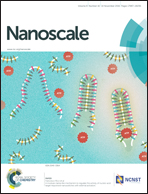Electron microscopy reveals a soluble hybrid network of individual nanocrystals self-anchored by bifunctional thiol fluorescent bridges†
Abstract
Today, nanochemistry research of hybrid materials growth in liquid media represents a new challenge for tailoring specific nano-sized materials directly related to the hybrid electron-optical properties. Distinctive assumptions about the origin, the growth, and the functionalization of hybrid nanoparticles have recently been proposed by scientific research to attend the different aspects of observable behaviors. Therefore, appropriate morpho-structural observation of the hybrid nanoparticles is the most important factor for controlling the chemical and physical properties. Here, we report how the gold nanocrystals (Au-NCs) structurally covered by an outer layer material of 9,9-didodecyl-2,7-bisthiofluorene (FL) bifunctional stabilizer evolve into a self-organized 2D-network as a function of different nano-structural features. Detailed morpho-structural investigation of this hybrid material through electron microscopy techniques has been performed from the atomic-scale to hundreds of nanometers. The experimental information gathered allowed us to figure out the evolution growth of the gold-FL nanoparticles (AuFL-NPs) from the early stage of the gold–organic nucleation to the final assembled bi-dimensional network. The reported results represent a valuable background toward the full comprehension of growth mechanisms of organic–inorganic materials responsible for the final chemical and physical properties.



 Please wait while we load your content...
Please wait while we load your content...